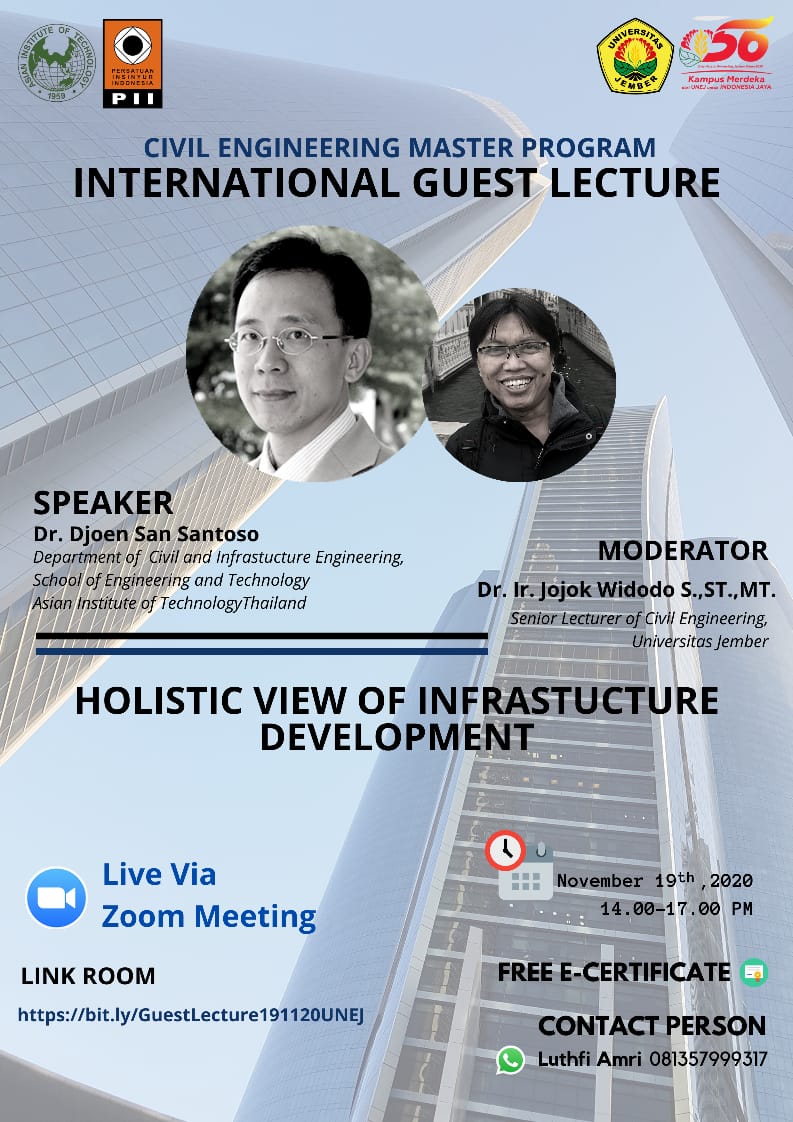Civil Engineering Department of Universitas Jember is holding an International Guest Lecture on Infrastructure Development Day 2 with a topic about ‘Holistic View Of Infrastructure Development’ on Thursday, November 19th 2020. This lecture is running online with Zoom Application and attended by about 500 participants. The participants are consist of the Head of Civil Engineering, College at The Institute of Indonesia Engineers (PII), students from the Asian Institute of Technology Thailand, students from non-UNEJ, academics, and students of Universitas Jember.
This lecture led by Dr. Ir. Jojok Widodo S., ST., MT with Dr. Anik Ratnaningsih, S.T., M.T. as master of ceremony. Dr. Ir delivers the opening speech. Iwan Taruna, M.Eng. The speaker in this International Guest Lecture is Dr. Djoen San Santoso from the Asian Institute of Technology Thailand. Dr. Djoen San Santoso is a Senior Fellow of the Department of Civil and Infrastructure Engineering, School of Engineering and Technology at Asian Institute of Technology Thailand. Dr. Djoen San Santoso had a research interest in Infrastructure planning and management, asset management, facility performance evaluation, risk management, culture in infrastructure and construction, public-private partnerships, sustainable transportation in developing countries. He also took positions as Associate Professor of School of Engineering and Technology (SET), ASIAN INSTITUTE OF TECHNOLOGY, Bangkok, Thailand.

In this lecture, Dr. Djoen San Santoso explained about infrastructure. All public and private facilities provide essential public services of transportation, utilities (water, gas, electric), energy, telecommunications, waste disposal, parklands, sports, recreational facilities, and housing called infrastructure. There are 3 components of infrastructure, such as institutional infrastructure, personal infrastructure, and physical infrastructure. He also explained about infrastructure management that consists of six keys: planning, design, construction, operation, maintenance, and recycling or disposal. The planning stage involves establishing the need and objectives of the project. The three main factors that should be collected are information about the project, information relating to the project’s location, and potential consequences in terms of cost and benefits. The design stage involves putting the client’s idea, planning parameters, and constraints on paper. The construction stage involves managing various resource inputs (labor, materials, plants) to produce the end-product. The operational stage focused on service quality to users/customers like adequate facilities management until it becomes sustainable. The last stage is the recycling and disposal stage, this stage is only for projects or facility that already reach its economic life.
The holistic view is active life-cycle management of major assets and components from design and inception to disposal. Factors that should be considered holistically for mass rail rapid transit development are the connection among lines and transit, feeders to the systems, land availability, integration with other transportation systems, and electricity supply. Dr. Djoen San Santoso also said that higher socio-economic and human development levels inversely proportional to higher demand for infrastructure. Studies show a strong connection between economic growth and infrastructure (road, air, and urban infrastructure).
During the lecture, the participant is very attracted and asks many questions about the Holistic View of Infrastructure Development. Even though the pandemic was still ongoing, it didn’t decrease participants’ enthusiasm to learn and gain lessons in civil engineering.



